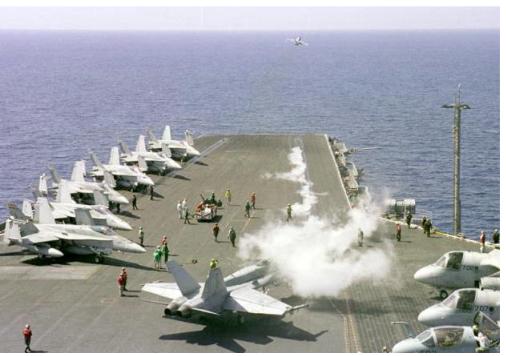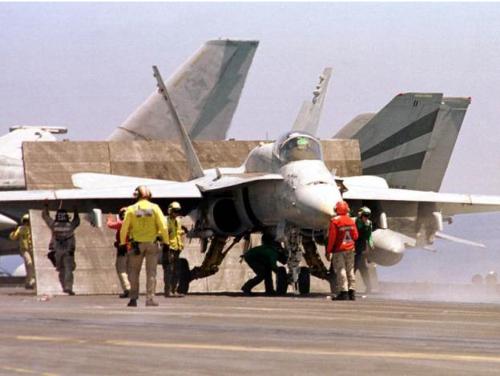Flight
Deck Safety
|
| Color Coded Classification System | Safety Guidelines | Deck Edge Fire Fighting Symbols |
| The carrier flight deck is one of the most
hazardous portions of real estate on the planet. It is a million accidents
waiting to happen.
For that very reason medical personnel are stationed on the flight deck to act as first responders in the event of an accident or medical emergency. Any time there are preparations for flight operations flight quarters will be announced to all hands over the ship’s 1MC announcing system and the flight deck will be manned as prescribed by the watch, quarter, and station bill. Crewmembers not directly involved in flight operations are not permitted on the flight deck or in the catwalks. |
Color Coded Classification System
|
Those crewmembers who do have specific, clearly defined functions will be readily recognizable at a glance by the colored coded jerseys and helmets that denote their role. The color classification system is as follows:
|
Anytime a medical representative is required on the flight deck they will be issued the proper safety equipment. The required flight deck protective equipment (NA00-80T-105/106) will always include the following items:
- Flight deck (steel-toed) safety shoes - All personnel assigned workstations on the flight deck, catapult and arresting gear, aviation fuels and ordnance spaces shall wear flight deck safety shoes.
- Prescribed properly stenciled protective jersey - Those personnel assigned flight quarters stations on or above the hangar deck shall wear the prescribed, properly stenciled protective jersey.
- HGU-24/P or -25/P cranial impact helmet - Flight deck personnel shall wear the HPG-24P/25P cranial impact helmet or equivalent during flight operations.
- Protective Eye Goggles
- Sound attenuators, which is usually incorporated into the HGU-24/P helmet
- Flotation gear “Float Coat” with the accompanying equipment to include a dye marker, whistle and survival light.
While exhaustive training in flight deck safety is beyond the scope of this text there are general safety rules to follow that can keep you safe on the hazardous flight deck environment.
Basic
Rules to live by on the flight deck:
- Unless you have specific business on the flight deck, stay off the flight deck and the adjacent catwalks during flight quarters.
This can be considered as safety precaution number one
- Wear your appropriate personal protective equipment listed above.
- Keep your head on a swivel. It’s what you can’t see that will hurt you.
- Become familiar with the physical layout of the flight deck (i.e., elevators, fire stations, foul deck line, spotting plan, etc)
- Be alert for aircraft and ammunition elevators that are not in the full-up position.
- Watch when crossing catapult tracks -- step over them, not on them.
- Be alert for the raising/lowering of jet blast deflectors (JBDs) and elevators.
- Stay clear of catapult and aircraft landing areas unless you have a participation in those operations.
- Always assume an aircraft has its engine turning if you see a man in the cockpit.
- Avoid movable surfaces of an aircraft while the engines are turning.
- Be alert for unexpected ship movements.
- Be alert for deck areas that are slick due to fluid, e.g., fuel, oil, hydraulic fluid spills.
- Minimize the items that you carry in your pockets and keep all potentially loose gear secure.
- Do not wear jewelry such as neck chains or bracelets while on the flight deck
- Ensure that you and your personnel adhere to safety policies and regulations at all times.
- Know your fatigue limits, it can kill.
- Never come up on the flight deck via the bow catwalks during launch operations and never come up on the flight deck via the port catwalks during recovery operations.
- Use the island structure. Never block entrances to the island structure or exits leading off the catwalks
- Never walk in front of an aircraft which is being armed or de-arming forward firing ordnance.
- Avoid propeller arcs and jet intakes/exhausts.
- Stay as least 25 feet from all intakes and propellers.
- Avoid jet exhaust by at least 150 feet when possible.
- Never place yourself to the outboard side of the aircraft being taxied or towed.
- Remain clear of helicopter rotor arcs (tip path plane) when they are engaging or disengaging rotors.
- Never cross the deck in front of a taxiing aircraft. Don't turn your back on recovering aircraft, taxiing aircraft or rolling stock that is not tied
Deck
Edge Fire Fighting Symbols
In addition to knowing the required flight deck safety equipment it’s also important to your fire fighting agents. You may be the first one on the scene of a fire on the flight deck and knowing the identification, function, and location of the various fire fighting agents could make the difference between extensive material damage/death of minimal injury. The fire fighting agents include:
- Purple K Powder Markings: This agent will be marked with a 12-inch wide red stripe and is painted up and over the deck edge wheel stop (also known as coamings) with a white 3-inch high “PKP” in the center of the stripe. At locations where coamings are not installed, stowage location is marked by a white,18-inch diameter circle on the flight deck. A red 5-inch high “PKP” designation is centered in the circle
- Saltwater Stations Markings: This Sea water hose will be marked with a 18-inch wide red stripe and is painted up and over the deck edge coaming. A yellow 3-inch high “W” in the center of the stripe. At locations where coamings are not installed, stowage location is marked by a red triangle 18-inches per side painted on the flight deck. A yellow “W” designation in centered in the triangle.
- CO2 Bottle Stowage Marking: This agent will be marked with a 12-inch wide red stripe and is painted up and over the deck edge wheel stop coaming with a white 3-inch high “CO2” in the center of the stripe. At locations where coamings are not installed, stowage location is marked by a white,18-inch diameter circle painted on the flight deck. A red 5-inch high “CO2” designation is centered in the circle.
- AFFF Station Markings: This agent will be marked with a 18-inch wide green stripe and is painted up and over the deck edge wheel stop coaming with a white 3-inch high “AFFF” in the center of the stripe. At locations where coamings are not installed, stowage location is marked by a green,18-inch square painted on the flight deck with a white “AFFF” letters painted in centered in the square.
- Bomb Jettison Ramp Markings: For ramps designated to eliminate loose ordinance will have a yellow stripe painted up and over the deck edge at both ends of the ramp opening. The flight deck in front of the ramp opening is marked with an alternating 4-ich wide red and yellow stripes with a 12-inch black facsimile of a bomb centered.
Through adequate familiarization of the flight deck environment and the associated hazards medical personnel can perform their medical duties in a safe and efficient manner.
This section was contributed by CDR Jay S. Dudley, MC, USN (FS).
Bureau of Medicine and
Surgery |
Operational
Medicine |
United States Special Operations Command 7701 Tampa Point Blvd. MacDill AFB, Florida 33621-5323 |
Home · Military Medicine · Sick Call · Basic Exams · Medical Procedures · Lab and X-ray · The Pharmacy · The Library · Equipment · Patient Transport · Medical Force Protection · Operational Safety · Operational Settings · Special Operations · Humanitarian Missions · Instructions/Orders · Other Agencies · Video Gallery · Phone Consultation · Forms · Web Links · Acknowledgements · Help · Feedback ·
This web version is brought to you by The Brookside Associates Medical Education Division · Other Brookside Products · Contact Us

